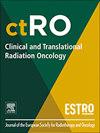新辅助放化疗后直肠癌患者的显微壁内扩散
IF 2.7
3区 医学
Q3 ONCOLOGY
引用次数: 0
摘要
目的研究直肠癌全肠系膜切除(TME)患者新辅助(化疗)放疗后的显微壁内扩散(MIS),探讨直肠内放射增强(如近距离接触放射治疗(CXB))或局部切除时额外治疗间隙的必要性。方法对2016年至2022年马斯特里赫特大学医学中心(MUMC +)治疗的一组患者进行分析。患者在放疗后6周接受MRI、CT扫描和乙状结肠镜检查,随后进行手术。对TME标本进行病理分析,包括整个挂载宏盒,测量肉眼残余肿瘤和MIS。分别记录平行于和垂直于肠壁的碎片状和连续状MIS。结果54例患者中,37例(69%)未出现MIS。4/18(22%)的ycT1-2肿瘤患者和13/36(36%)的ycT3-4肿瘤患者出现MIS。连续性MIS 4例(7%),碎片性MIS 15例(28%)。没有ypT1-2患者发生MIS。结论69%的患者在新辅助治疗后未保留MIS。了解肿瘤的厚度似乎是选择CXB患者的关键。本文章由计算机程序翻译,如有差异,请以英文原文为准。
Microscopic intramural spread in patients with rectal cancer after neoadjuvant chemoradiation
Objective
This study investigates microscopic intramural spread (MIS) after neoadjuvant (chemo)radiotherapy on Total Mesorectal Excision (TME) specimens of rectal cancer patients and explores the necessity of an additional treatment margin for endorectal radiation boosts (for example through contact brachytherapy (CXB)) or local excisions.
Methods
A cohort of patients from Maastricht University Medical Center (MUMC + ) treated between 2016 and 2022 was analyzed. Patients underwent MRI, CT scans, and sigmoidoscopy six weeks after radiotherapy, followed by surgery. Pathological analysis of TME specimens, including whole mount macro-cassettes, was performed to measure residual macroscopic tumor and MIS. Fragmented and continuous MIS were recorded parallel and perpendicular to the bowel wall.
Results
Out of 54 patients, 37 (69%) exhibited no MIS. MIS was observed in 4/18 (22%) of patients with ycT1-2 tumors and 13/36 (36%) of patients with ycT3-4 tumors. 4 patients (7%) showed continuous MIS and 15 (28%) showed fragmented MIS. No patients with ypT1-2 had MIS.
Conclusions
69% of patients do not retain MIS post-neoadjuvant therapy. Knowledge of tumor thickness seems crucial for patient selection for CXB.
求助全文
通过发布文献求助,成功后即可免费获取论文全文。
去求助
来源期刊

Clinical and Translational Radiation Oncology
Medicine-Radiology, Nuclear Medicine and Imaging
CiteScore
5.30
自引率
3.20%
发文量
114
审稿时长
40 days
 求助内容:
求助内容: 应助结果提醒方式:
应助结果提醒方式:


